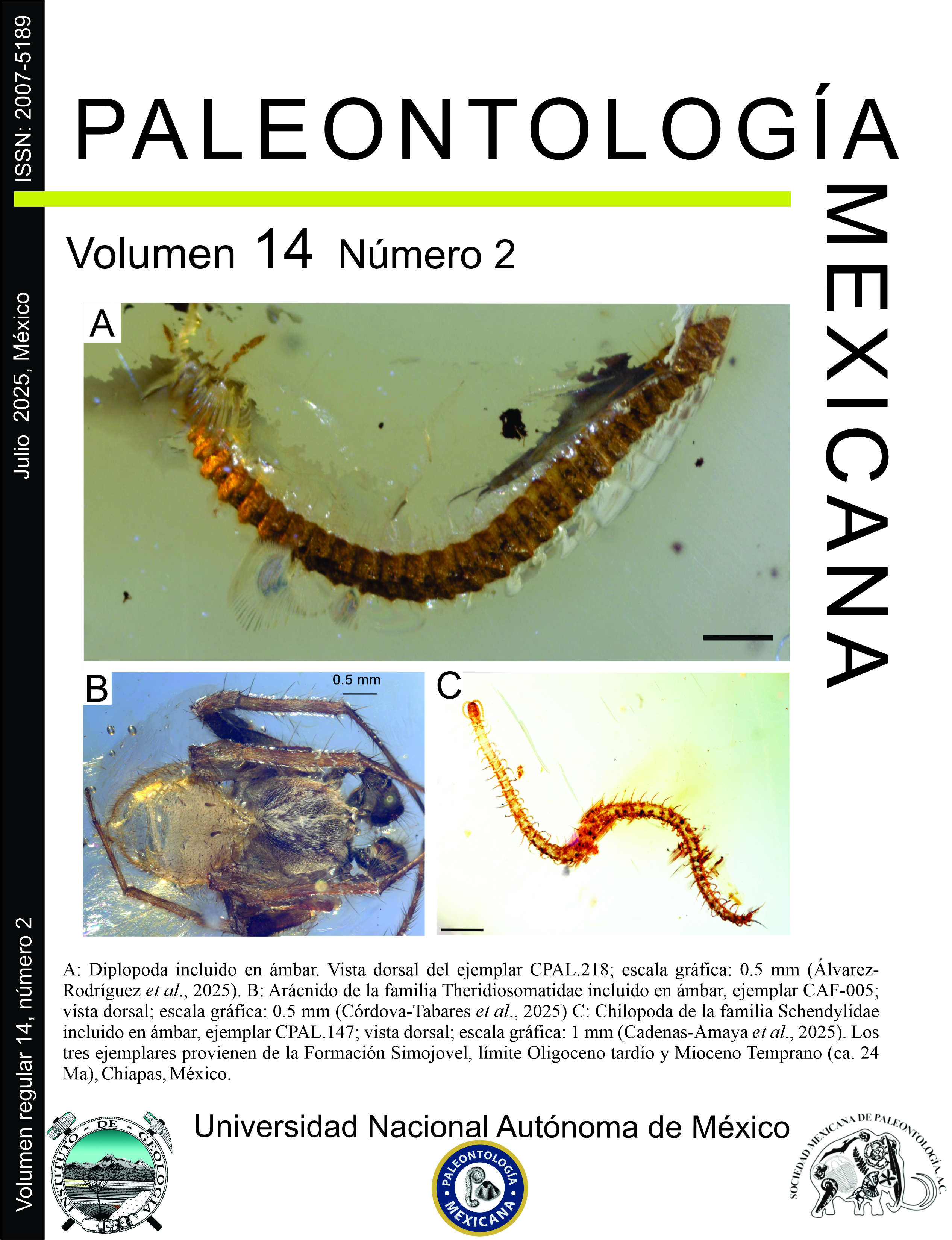Diplopoda en ámbar mexicano: Listado taxonómico adicional
Contenido principal del artículo
Resumen
El registro fósil de milpiés (Myriapoda: Diplopoda) en México se encuentra principalmente en los estratos de ámbar de la parte superior de la Formación Simojovel en Chiapas, que data del límite superior del Oligoceno tardío y el inferior del Mioceno temprano, ca. 24 Ma. Presentamos una lista taxonómica revisada de milpiés fósiles en México para complementar el catálogo global existente. Esta compilación revisada incluye 85 inclusiones de ámbar, organizadas en los siguientes órdenes: Polyxenida (cinco registros), Platydesmida (cuatro registros), Siphonophorida (17 registros), Polydesmida (49 registros), Stemmiulida (un registro), Julida (un registro) y otros no asignados debido a restricciones de preservación. Se incluyen nuevos registros de Chelodesmidae, Pyrgodesmidae, Sphaeriodesmidae y Trichopolydesmidae dentro de Polydesmida. Se proporcionan descripciones y comentarios para cada registro. Este inventario destaca la biodiversidad de Diplopoda en el sur de Norteamérica y apoya los esfuerzos de conservación del material fósil en México.
Detalles del artículo

Esta obra está bajo una licencia internacional Creative Commons Atribución-NoComercial-SinDerivadas 4.0.
Citas
Allison, R. C. (1967). The Cenozoic Stratigraphy of Chiapas, Mexico, with Discussions of the Classification of the Turritellidae and Selected Mexican representatives. [Unpublished PhD Thesis], University of California at Berkeley.
Álvarez-Rodríguez, M., Riquelme, F., Hernández-Patricio, M., & Cupul-Magaña, F. (2024). Diplopoda in the world fossil record. Zoological Systematics, 49(3), 185–245. https://doi.org/10.11865/zs.2024201
Baalbergen, E., & Donovan, S. K. (2012). Terrestrial arthropods from the Upper Pleistocene of Jamaica: systematics, palaeoecology and taphonomy. Geological Journal, 48(6), 628–645. http://dx.doi.org/10.1002/gj.2477
Bueno-Villegas, J., Sierwald, P., & Bond, J. E. (2004). Diplopoda. In B. Llorente, J. Morrone, O. Yañez, & I. Vargas (Eds.), Biodiversidad, Taxonomía y Biogeografía de Artrópodos de México. Hacia una síntesis de su conocimiento (4th ed., pp. 569–599). UNAM-CONABIO, México. https://doi.org/10.21829/azm.2014.303100
Edgecombe, G. D. (2015). Diplopoda: Fossils. In A. Minelli (Ed.), Treatise on Zoology Anatomy, Taxonomy, Biology. The Myriapoda, Vol. 2 (pp. 337–352). Brill, Netherlands. https://doi.org/10.1163/9789004188273
Enghoff, H. (2015). Diplopoda: Geographical distribution. In A. Minelli (Ed.), Treatise on Zoology Anatomy, Taxonomy, Biology. The Myriapoda, Vol. 2 (pp. 329–336). Brill, Netherlands. https://doi.org/10.1163/9789004188273
Enghoff, H., Golovatch, S., Short, M., Stoev, P., & Wesener, T. (2015). Diplopoda: Taxonomic overview. In A. Minelli (Ed.), Treatise on Zoology Anatomy, Taxonomy, Biology. The Myriapoda, Vol. 2 (pp. 363–453). Brill, Netherlands. https://doi.org/10.1163/9789004188273
Frost, S. H., & Langenheim, R. L. (1974). Cenozoic Reef Biofacies, Tertiary Larger Foraminifera and Scleractinian Corals from Chiapas, Mexico. Northern Illinois University Press, De Kalb.
Graham, A. (1999). Studies in neotropical paleobotany. XIII. An Oligo-Miocene palynoflora from Simojovel (Chiapas, Mexico). American Journal of Botany, 86, 17–31. https://doi.org/10.2307/2656951
Golovatch, S. I. (2013). A reclassification of the millipede superfamily Trichopolydesmoidea, with descriptions of two new species from the Aegean region (Diplopoda, Polydesmida). ZooKeys, 340, 63–78. https://doi.org/10.3897/zookeys.340.6295
Hoffman, R. L., Golovatch, S. I., Adis, J., & Demarais, J. W. (1996). Practical keys to the orders and families of millipedes of the Neotropical region (Myriapoda: Diplopoda). Amazoniana, 14, 1–35.
Koch, M. (2015). Diplopoda: General morphology. In A. Minelli (Ed.), Treatise on Zoology Anatomy, Taxonomy, Biology. The Myriapoda (2nd ed., pp. 7–69). Brill, Netherlands. https://doi.org/10.1163/9789004188273
Langenheim, J. H. (1966). Botanical source of amber from Chiapas, Mexico (Fuente botánica del ámbar de Chiapas, México). Ciencia, 24(5–6), 201–210.
Langenheim, J. H. (2003). Plant resins: chemistry, evolution, ecology, and ethnobotany. Timber Press. https://doi.org/10.1600/036364404772974374
Latreille, P. A. (1802). Histoire naturelle, générale et particulière des Crustacés et des Insectes. Dufart.
Lucas, H. (1840). Histoire Naturelle des Crustacés, des Arachnides et des Myriapodes. Duménil.
Perrilliat, M., Vega, F., & Coutiño, M. (2010). Miocene mollusks from the Simojovel area in Chiapas, southwestern Mexico. Journal of South American Earth Sciences, 30(2), 111–119. https://doi.org/10.1016/j.jsames.2010.04.005
Riquelme, F., & Hernández-Patricio, F. (2018). The millipedes and centipedes of Chiapas amber. Check List, 14, 637–646. https://doi.org/10.15560/14.4.637
Riquelme, F., Alvarado-Ortega, J., Ramos-Arias, M., Hernández, M., le Dez, I., Lee-Whiting, T. A., & Ruvalcaba-Sil, J. L. (2013). A fossil stemmiulid millipede (Diplopoda: Stemmiulida) from the Miocene amber of Simojovel, Chiapas, Mexico. Historical Biology, 26(4), 415–427. https://doi.org/10.1080/08912963.2013.778843
Riquelme, F., Ruvalcaba-Sil, J. L., Alvarado-Ortega, J., Estrada-Ruiz, E., Galicia-Chávez, M., Porras-Múzquiz, H., Stojanoff, V., Siddons, D. P., & Miller, L. (2014a). Amber from México: Coahuilite, Simojovelite and Bacalite. MRS Proceedings, 1618, 169–180. https://doi.org/10.1557/opl.2014.466
Riquelme, F., Hernández-Patricio, M., Martínez-Dávalos, A., Rodríguez-Villafuerte, M., Montejo-Cruz, M., Alvarado-Ortega, J., Ruvalcaba-Sil, J., & Zúñiga-Mijangos, L. (2014b). Two flat-backed polydesmidan millipedes from the Miocene Chiapas-Ambers Lagerstätte, Mexico. PLoS ONE, 9, e105877. https://doi.org/10.1371/journal.pone.0105877
Riquelme, F., Hernández-Patricio, M., & Álvarez-Rodríguez, M. (2021). A Miocene pyrgodesmid millipede (Polydesmida: Pyrgodesmidae) from Mexico. PeerJ, 9(2), e10574. http://dx.doi.org/10.7717/peerj.10574
Riquelme, M., Ortega-Flores, B., Estrada-Ruiz, E., & Córdova-Tabares, V. (2025). Zircon U–Pb ages of the Chiapas Amber-Lagerstätte in the uppermost Simojovel Formation, southwest Mexico. Canadian Journal of Earth Sciences, 62(6), 1–16. https://doi.org/10.1139/cjes-2024-0100
Shear, W. A. (2011). Class Diplopoda de Blainville in Gervais, 1844. In Z. Q. Zhang (Ed.), Animal Biodiversity: An Outline of Higher-level Classification and Survey of Taxonomic Richness (3148, pp. 169–164). Zootaxa. https://doi.org/10.11646/zootaxa.3148.1.32
Shelley, R. M., & Golovatch, S. I. (2011). Atlas of Myriapod Biogeography. I. Indigenous Ordinal and Supra-Ordinal Distributions in the Diplopoda: Perspectives on Taxon Origins and Ages, and a Hypothesis on the Origin and Early Evolution of the Class. Insecta Mundi, 158, 1–134.
Sierwald, P., & Bond, J. (2007). Current Status of the Myriapod Class Diplopoda (Millipedes): Taxonomic Diversity and Phylogeny. Annual Review Entomology, 52, 401–420. https://doi.org/10.1146/annurev.ento.52.111805.090210
Wesener, T., & Moritz, L. (2018). Checklist of the Myriapoda in Cretaceous Burmese amber and a correction of the Myriapoda identified by Zhang (2017). Check List, 14(6), 1131–1140. http://dx.doi.org/10.15560/14.6.1131
